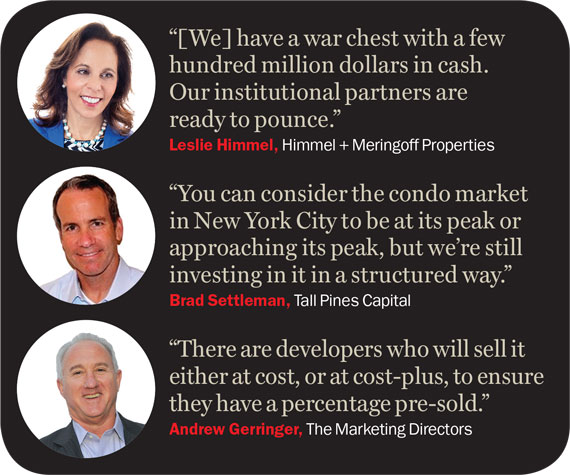 It’s easy to make money when the market is chugging along, but what strategies do real estate players use when the market nears its peak?
It’s easy to make money when the market is chugging along, but what strategies do real estate players use when the market nears its peak?
New York City developers and investors are now preparing for that day — and the days beyond that, when the landscape doesn’t look quite as rosy as it does right now.
Strategies, of course, vary. Some of these players are shifting gears and selling buildings, while others are finding more conservative ways to place their investments in properties or stockpiling cash to buy real estate when prices start dropping.
As The Real Deal reported last month, Emanuel “Manny” Stern, the head of Tall Pines Capital, is avoiding ground-up residential development and instead partnering with big-time developers on mezzanine debt and preferred equity investments.
Stern — the former CEO of Hartz Mountain Industries, founded by his billionaire father Leonard Stern — and his partner, Brad Settleman, believe that approach will leave them less financially exposed.
“You can consider the condo market in New York City to be at its peak or approaching its peak, but we’re still investing in it in a structured way,” Settleman said.
This month, TRD talked to lawyers, financial experts, developers and investors to find out what sorts of strategy shifting they’re either considering or acting on.
To be sure, the marketplace is full of opinions as to when the next downturn will come. And many players said the cycle still has plenty of legs. But for every buyer, there’s a seller, and those who think the current cycle is in the later innings — to use a baseball analogy — are acting accordingly.
Stern said it’s easier in “the fifth and sixth innings” of the cycle when “the wind is at your back.” But he said it’s also possible to succeed in this later-innings phase.
“You can make money if you’re good at every inning in the cycle,” he said.
Mezzanine madness
Stern and Settleman are not the only ones looking to steer clear of new residential construction and find safer financial investments.
Investors who find the market too frothy are also increasingly opting to place their dollars as mezzanine-debt and preferred-equity alternatives, which sponsors bring into their capital stacks to fill the gap between common equity and senior debt.
While both offer lower returns than common equity, they sit further down in the stack, where there is less risk.
 Mezz debt and preferred equity arguably serve the same financial functions. But the key difference is that the former requires the investor to foreclose on a property in order to take it over, while with the latter, the investor can take control without taking that litigious step.
Mezz debt and preferred equity arguably serve the same financial functions. But the key difference is that the former requires the investor to foreclose on a property in order to take it over, while with the latter, the investor can take control without taking that litigious step.
Graham Hobbs, a capital markets broker with Savills Studley, said that over the last 18 months he’s seen investors who would normally enter a deal as a joint-venture partner with common equity diversify their holdings and place some of their money lower in the stack. It’s a play that allows them to spread the risk.
“As pricing increases, it’s allowed them to be more comfortable with the last dollar,” Hobbs said. “They’re giving up potential upside, but the risk-adjusted return is safer.”
One buyer using that strategy is Midtown-based ATCO Properties, which since 2009 has been in acquisitions mode, investing as a general partner in office and retail properties in places like Austin, Connecticut and North Carolina.
But the fourth-generation family company, which owns office buildings like 555 Fifth Avenue and 381 Park Avenue South, is now taking a more conservative approach, launching a mezzanine-debt and preferred-equity program. Over the summer, ATCO put up $12.7 million for Blesso Properties’ $33 million acquisition of 525-545 Broadway in Williamsburg, a development site with almost 200,000 square feet of buildable space.
Damon Hemmerdinger, co-president of ATCO, said he’s put a hold on buying properties outright.
“We’re targeting the same buildings we’ve been working on acquiring and coming in lower in the capital stack,” he said. “Obviously they’re capped returns. But we saw in a number of cases the returns we were projecting [as a general partner on one deal] were actually lower than or equal to what we would get in the mezz and preferred position [on another].”
The syndication hedge
Insiders said they’re also seeing an increase in residential condo developers in the city offering so-called syndication purchases to investors. The move allows developers to hedge their bets by pre-selling inventory to inside buyers.
The way it works is that the investor comes into a deal by acquiring an interest in a “syndication,” or the entity developing the project, sometimes an LLC created by the developer. Once the condo offering plan is approved, the buyer can convert the investment into a condo at the project.
For the developer, it can help to secure financing by assuring that somewhere between 5 to 15 percent of a project’s inventory is essentially pre-sold. For the investor, the upside is the ability to buy real estate at a below-market rate. “There are developers who will sell it either at cost, or at cost-plus, to ensure they have a percentage pre-sold,” said new-development specialist Andrew Gerringer of The Marketing Directors. “You can buy it at a number you could rent at and hold it until the market improves.”
The practice is not new, but it’s been occurring with more frequency. In fact, two years ago the New York State attorney general’s office cited an uptick when it issued a memo clarifying its position on syndication purchases, which — while technically legal — violated the state’s General Business Law in instances where the buyer didn’t have the ability to opt out of the condo purchase.
 The AG’s memo gave the green light so long as sponsors made certain disclosures and gave investors the option to cash out on their investment, paving the way for them to use the tactic more.
The AG’s memo gave the green light so long as sponsors made certain disclosures and gave investors the option to cash out on their investment, paving the way for them to use the tactic more.
Real estate attorney Edward Mermelstein said he’s seeing it on a daily basis. He described it as a strategy developers are taking “to protect themselves as things move forward.”
“This is definitely a hedge where you’re confident that at least a portion of your property is going to be sold, even though it is going to be to insiders,” he said. “In certain cases, it’s a psychological position.”
Positioning to pounce
During the last downturn, those who snapped up distressed assets when the market bottomed out (and then patiently waited for the rebound) made out well.
Manhattan office properties, for example, were trading for a median price of $392 per square foot in the first half of 2009, according to data from Massey Knakal Realty Services, which is now owned by Cushman & Wakefield. Prices have since tripled, to a median of $1,166 per square foot through the first two quarters of this year.
One big winner was the partnership of Crown Acquisitions, Lloyd Goldman and the Feil Organization. The savvy investors pooled their dollars to buy the retail at the St. Regis Hotel for $117 million in 2009 and made a 167 percent return on their equity when they sold it three years later for $380 million.
Some investors are now hoping to replicate that type of success when the market makes its next serious “correction.”
Leslie Himmel, a managing partner at Himmel + Meringoff Properties, a privately held real estate company that owns a large Manhattan office portfolio, said that over the past two or three years the firm has been filling its coffers by refinancing each building in the company’s roughly 2-million-square-foot portfolio “even if the loans weren’t coming due.”
The company, she said, is ensuring it has plenty of cash on hand so that it can buy up properties when prices drop. In addition, Himmel noted that she is already having conversations with her institutional partners about making acquisitions when the time is right. “[We] have a war chest with a few hundred million dollars in cash,” she said. “Our institutional partners are ready to pounce.”
Savills Studley’s Hobbs, however, said that those who are waiting may be playing it too safe. “The reality is, if you’re sitting around waiting for things to happen, you could be sitting on your hands for a while,” he said. “People have been saying the market is going to correct for a year or two. Those people are still waiting on
the sidelines.”
